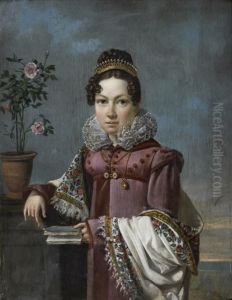Jean-Pierre De Saint-Ours Paintings
Jean-Pierre De Saint-Ours was a Swiss painter born on April 4, 1752, in Geneva. He belonged to the late Baroque and early Neoclassical periods, which were characterized by a shift away from the ornate and dramatic styles of the Baroque towards a new emphasis on simplicity, clarity, and classical themes drawn from ancient Greece and Rome.
De Saint-Ours initially trained under his father Jacques De Saint-Ours, who was a painter and an art instructor. He later continued his studies in Paris, which was then one of the leading centers of art in Europe. His time in Paris exposed him to the works of contemporary French artists and the emerging Neoclassical style, which would greatly influence his own artistic development.
After his time in Paris, De Saint-Ours traveled to Italy, as was customary for many artists of the period who sought to study the masterpieces of the Renaissance and antiquity. His travels and studies further enriched his understanding of classical art, which would be evident in his later works.
Upon returning to Geneva, De Saint-Ours became an active member of the city's artistic community. He painted a variety of subjects, including portraits, historical scenes, and mythological subjects. His style was marked by a refined elegance and a clear, harmonious composition, which was well received by his contemporaries. He was particularly noted for his ability to depict fabrics and textures with great skill, which added a tactile quality to his work.
De Saint-Ours also engaged in teaching, passing on his knowledge and skills to the next generation of artists. He was a respected figure in Geneva's cultural circles, contributing not only through his art but also through his involvement in various artistic societies.
Jean-Pierre De Saint-Ours' career was a reflection of the artistic transitions taking place in Europe during his lifetime. His work captures the shift from the Baroque to the Neoclassical and offers insight into the cultural milieu of late 18th-century Geneva. He continued to work and teach until his death on September 7, 1809. Today, De Saint-Ours is remembered for his contributions to Swiss art and the broader narrative of European artistic evolution during a critical period of change.
